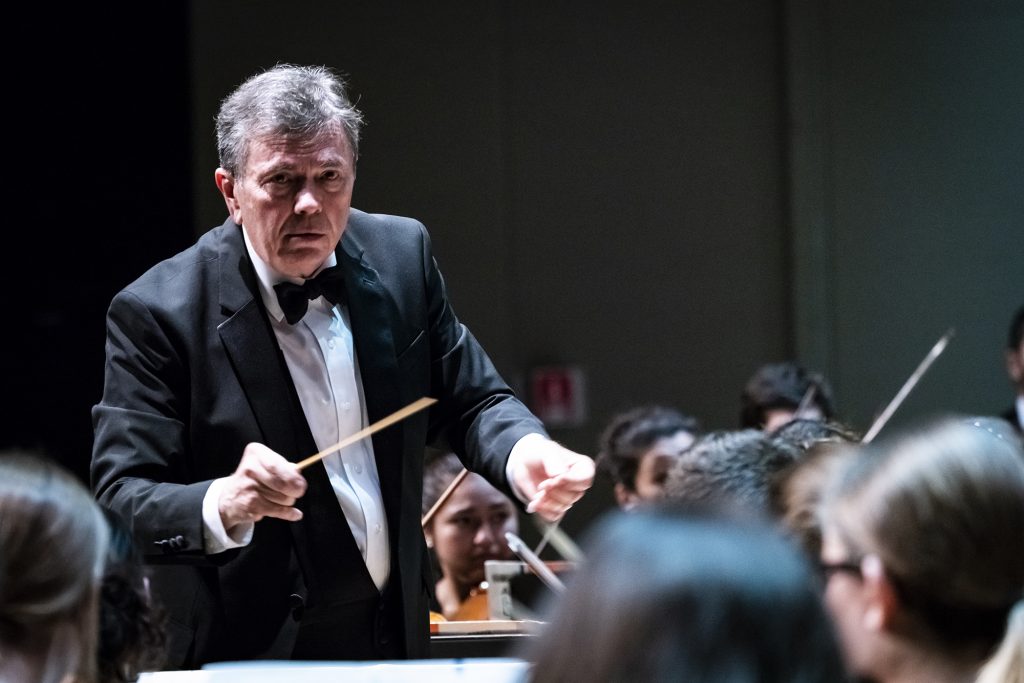Schwarz, Frost Symphony open season with varied program

The Frost Symphony Orchestra showed its versatility in Saturday night’s season-opening concert with rich, layered performances of works by a contemporary American composer, a revolutionary Russian and a master from the European heartland.
Under conductor Gerard Schwarz, an enthusiastic advocate of American music, the University of Miami’s student orchestra opened the concert—viewed via livestream from Gusman Hall—with Umoja by Valerie Coleman. A new member of the university’s faculty, Coleman is a flutist and the first black woman to have a work commissioned by the Philadelphia Orchestra.
Umoja, named for the Swahili word for unity, travels a long distance in 14 minutes or so of music, as Coleman attempts to portray the impact on society of racism and injustice. After composing it for women’s voices, she arranged it for wind quintet and then prepared an orchestral version.
The work opens with tones that suggest a sunrise, with swelling winds and shimmering dissonances. Bright melodies and broad harmonies evoke an America of wide-open spaces. At the same time, the skillfully crafted music has a busy, contrapuntal quality, like an Appalachian concerto grosso.
Angular tones in percussion and winds interrupt this idyll, which the Frost musicians brought off with a tone of controlled violence. After a few minutes of turbulence, a hard-won peace arrives, with strings playing over a pillow of low brass, for an ending that feel optimistic, hard-won and quietly triumphant.
Igor Stravinsky’s The Song of the Nightingale never achieved the popularity of his other major early-20th century works, The Firebird, Petrushka and The Rite of Spring.
But like those works, it’s full of exotic colors and dissonances that must have sounded particularly harsh at the time of its composition. And like the earlier works, it is virtuoso orchestra music. It bristles with exposed solo passages, rapid sections, odd rhythms and constant shifts in the time signature, the rhythmic grid on which the music is played.
Based on an opera Stravinsky wrote from a Hans Christian Andersen story, it tells of a nightingale that sings to a Chinese emperor, gets replaced by a mechanical nightingale and then returns to sing the dying emperor back to health.
Under Schwarz, the orchestra gave a polished performance. If the playing occasionally felt constricted, as if much of the effort was going into getting the notes right, the result was still energetic and assured, with ample swirling exoticism.
Solo playing was outstanding throughout. Flutist Dmytro Gnativ gave an agile and effortless account of the rapid notes of the nightingale’s song. Trumpeter Kevin Karabell phrased a fisherman’s song with warm, evocative tones.
The concert concluded with a core work of the orchestral repertory, Brahms’ Symphony No. 3, composed in 1883 (when Stravinsky, incidentally, was one year old).
Although this was the most familiar work on the program, the performance was the least polished, with ragged passages and intonation problems. But a performance doesn’t have to be note-perfect to be effective, and the orchestra under Schwarz gave a powerful and moving performance of Brahms’ most heroic symphony.
The Allegro con brio opened with grand, sweeping phrases, expressing the sheer largeness and scope of Brahms’ musical vision. Schwarz paced the Andante expertly, giving the music plenty of room to breathe, with stately pauses and unhurried, but never sluggish, phrasing. With shimmering strings and winds, he and the orchestra brought the movement to an effective climax.
The third movement opens with one of the composer’s most famous melodies, a milestone in the musical lives of many Brahms enthusiasts. The orchestra gave a stirring account, richly played but with a raw edge of emotion. The melody returned in different moods, alternately melancholy and contemplative, as it was taken up by winds and brass, finally returning for one last searing performance in the violins.
The last movement came with much of the heroic qualities of the first. The orchestra gave clipped and forceful accounts of the gruff, Beethovenian phrases, ratcheting up the excitement until the movement came to its quiet close.
Posted in Performances
Leave a Comment
Sun Sep 26, 2021
at 11:07 am
No Comments